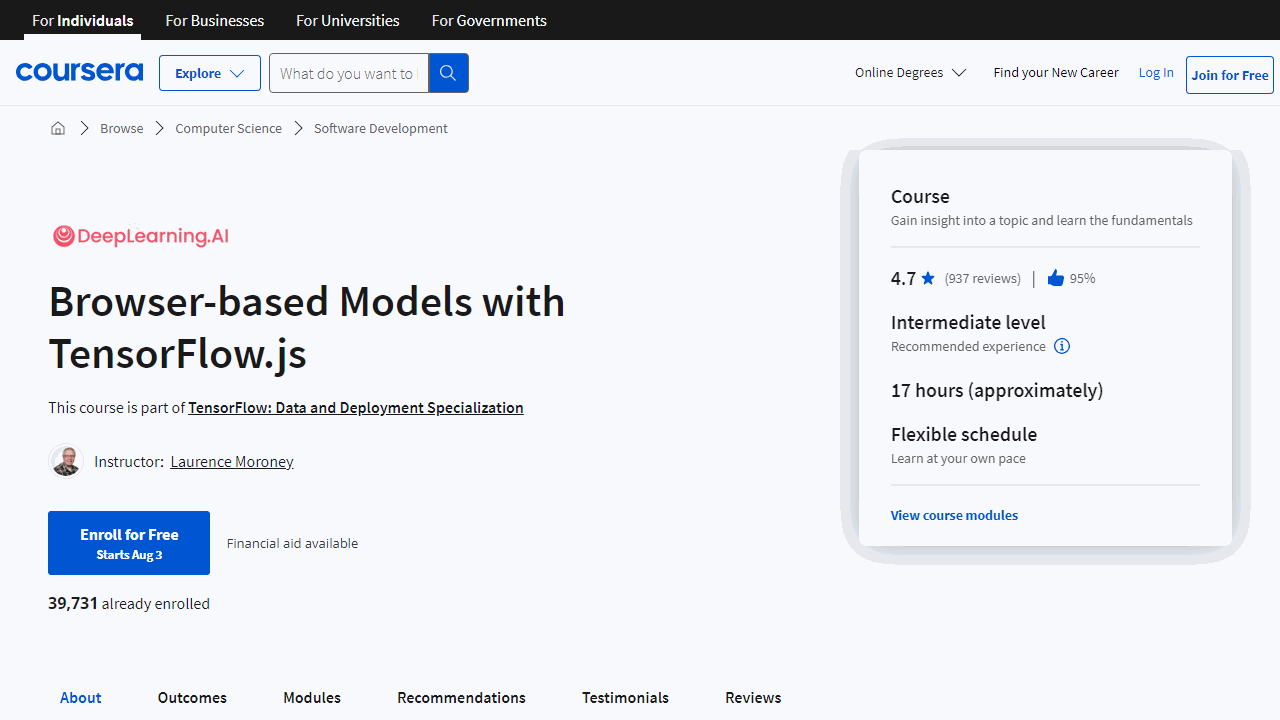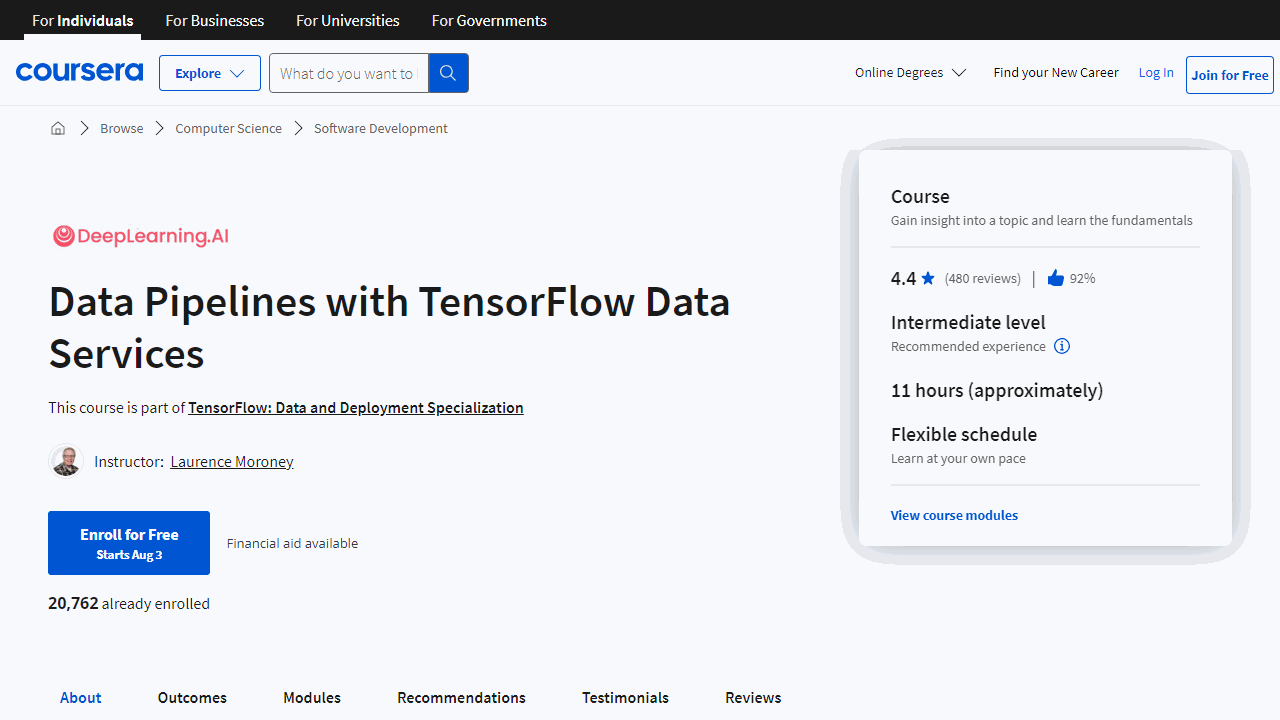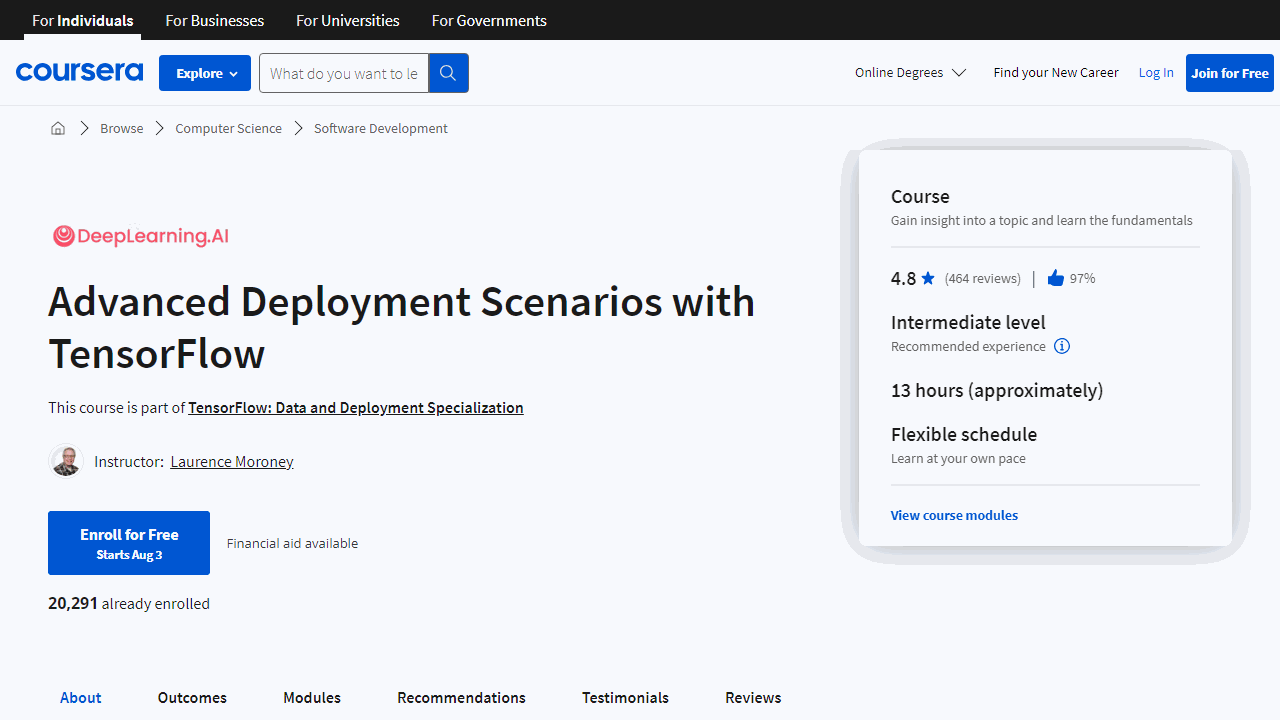- Rating: 4.7/5 with 1.251 ratings
- Provider: DeepLearning.AI
- Teacher: Laurence Moroney
- Price: $49/month with a 7-day free trial
- Duration: Approx. 1 months if you study 10 hours per week (40 hours total)
- Pre-requisites: basic Javascript, Kotlin or Swift, and TensorFlow knowledge
- Level: Intermediate
- Certificate: Yes
- Coursera Plus: No
If you’re a data science student with an interest in TensorFlow and machine learning, this article will guide you through a selection of courses offered in the TensorFlow: Data and Deployment Specialization, offered by DeepLearning.AI on Coursera.
What sets these courses apart is the combination of theoretical learning and hands-on assignments.
This approach ensures you not only understand the concepts but can also apply them in real-world situations.
A unique component of these courses is the opportunity to build an actual Web App, offering practical experience beyond the typical machine learning course.
So, get ready to expand your TensorFlow knowledge and learn how to deploy models on a variety of devices and environments.
Browser-based Models with TensorFlow.js
- Rating: 4.7/5 with 937 ratings
- Duration: Approx. 17 hours
If you’re on the hunt for a course to dive into the world of TensorFlow models in a browser setting, look no further.
This course is a brilliant choice, especially if you’re already comfortable with JavaScript (JS) and Machine Learning (ML).
One of the highlights of this course is its real-world application.
You’ll master the art of training and deploying ML models directly in JavaScript.
This is a must-have skill for those who aim to bypass back-end calls to Python while building web apps.
It’s a real game-changer for small-scale applications.
What’s more, you’ll also get the hang of training models in Python and then importing them into JS for inferences.
The course is well-designed, featuring concise videos and hands-on assignments.
The cherry on top is the final assignment - a solid reference for your future projects.
What sets this course apart is its practicality.
It gives you the opportunity to build an actual Web App!
This feature is a real asset when you want to demonstrate the value of Deep Learning in real-life scenarios.
The curriculum is clear, logical, and packed with elegant code examples.
Of course, every rose has its thorns.
Some students found the quizzes a bit monotonous as they were syntax-related.
Also, a few assignments seemed too similar to the examples which might affect your learning experience.
There were a few technical hiccups reported, particularly with the final project and the grading system.
Some students experienced crashes when the final project’s number of samples exceeded 50 on Windows.
Despite these challenges, the course has received high praise for its content.
It’s been hailed as insightful and helpful, particularly for front-end web developers keen on exploring deep learning through TensorFlow.
What You Will Learn
- Understand the basics of TensorFlow.js and its application in browser-based models.
- Learn how to build and train models using TensorFlow.js.
- Gain practical experience with coding through examples like the Iris Classifier.
- Explore the Iris Dataset and understand the concept of one-hot encoding.
- Dive into the world of Convolutional Nets and learn how to create one using JavaScript.
- Learn how to visualize the training process and understand the concept of a Sprite Sheet.
- Get introduced to pre-trained TensorFlow.js models and learn how to use them.
- Understand the process of converting models to JavaScript for browser-based applications.
- Learn how to build a simple web page using TensorFlow.js and retrain the MobileNet model.
- Gain hands-on experience with capturing data, training the network with captured data, and performing inference.
Device-based Models with TensorFlow Lite
- Rating: 4.7/5 with 595 ratings
- Duration: Approx. 9 hours
This course offers a balanced approach to TensorFlow model deployment on an array of devices.
It’s an excellent place to start if you’re interested in understanding the principles of TensorFlow Lite and how to deploy it on Android, Apple, and microcontrollers.
One of the main strengths of this course is its blend of theory and practice.
You’ll be exposed to real-life examples of using TensorFlow Lite on Raspberry, Android, and iOS devices.
This approach, coupled with well-organized course content and achievable assignments, helps you apply theoretical knowledge to practical scenarios.
The course covers a wide range of topics.
You’ll start with the basics of mobile AI and model architecture, gradually moving onto more complex subjects such as optimization techniques and quantization.
The course also delves into transfer learning, running models, and converting a model to TFLite.
While the course does have a strong theoretical foundation, it also incorporates practical elements.
It gives you a solid understanding before diving into the hands-on components.
However, some students have suggested that the course could benefit from additional mandatory hands-on assignments.
A unique aspect of this course is its focus on deploying TensorFlow models on edge devices.
With the increasing importance of edge computing in AI, this skill set is certainly valuable.
Plus, you’ll also learn about using TensorFlow Lite on low-power devices, which opens up a new realm of possibilities for AI applications.
This course is designed to be accessible to beginners, but having some knowledge of app development can enhance your learning experience.
It’s not a prerequisite to succeed in the course, but it can be beneficial.
What You Will Learn
- Understand the features and components of mobile AI and its architecture for optimal performance.
- Learn various optimization techniques for saving, converting, and optimizing a model.
- Explore the concept of quantization and TF-Select in the path of optimization.
- Gain practical knowledge on running models and implementing transfer learning.
- Master the process of converting a model to TFLite and applying transfer learning with TFLite.
- Get hands-on experience in initializing the Interpreter, preparing the Input, and understanding inference and results.
- Develop skills to classify camera images, initialize models, and prepare inputs.
- Discover the use of Swift in TensorFlowLiteSwift and its application in creating a Cats vs Dogs App.
- Learn to work on a Raspberry Pi, starting from image classification to object detection.
- Understand the role of microcontrollers in device-based models and their practical applications.
Data Pipelines with TensorFlow Data Services
- Rating: 4.8/5 with 480 ratings
- Duration: Approx. 10 hours
In this course, you’ll explore the ins and outs of Extract, Transform, and Load (ETL) processes, versioning datasets, and using TensorFlow Datasets (TFDS) in Keras for model training.
The course also exposes you to handling different types of data, like images and text, and advanced topics like caching and parallelism APIs.
A key strength of this course, as highlighted in student reviews, is the hands-on experience.
Real-world examples and assignments give you a chance to apply what you’ve learned, enhancing your understanding significantly.
Although the final assignment might be challenging, see it as an opportunity to stretch your skills.
Laurence Moroney’s teaching style is another highlight.
Students appreciate his deep commitment to their learning and enjoyment.
He presents complex topics in an engaging, accessible manner, making it a great course even for beginners.
However, some students have found the pace in weeks 3 and 4 a bit quick, suggesting extra time for reviewing the materials.
Also, a basic understanding of Python and TensorFlow is assumed, so brush up on these if needed.
Despite these minor hiccups, students generally agree that the course is an excellent resource for TensorFlow data pipelines.
It’s especially beneficial for Data Scientists and Machine Learning Engineers looking to operationalize their ML models.
What You Will Learn
- Understand the basics of data pipelines and their importance in machine learning and data science.
- Learn how to extract, transform, and load (ETL) data using TensorFlow.
- Gain knowledge on how to version datasets for better management and reproducibility of results.
- Get hands-on experience with TensorFlow Datasets (TFDS) in Keras to train models on popular datasets like Fashion MNIST and Horses or Humans.
- Dive deep into the Splits API and learn about file structure in TensorFlow Datasets and feature descriptors.
- Explore different types of data columns in TensorFlow, including numeric, bucketized, vocabulary, hashed, and embedding columns.
- Learn how to handle different types of data including Numpy, Pandas, Images, CSV, Text, and TFRecord.
- Understand the concept of ETL and what happens when you train a model, including caching, parallelism APIs, autotuning, and parallelizing data extraction.
- Learn best practices for code improvements and how to optimize your data pipeline for better performance.
- Get a walkthrough on how to start using a dataset, implement it in your pipeline, handle file access issues, and publish your dataset.
Advanced Deployment Scenarios With TensorFlow
- Rating: 4.8/5 with 464 ratings
- Duration: Approx. 11 hours
If you’re looking to dive deep into TensorFlow’s advanced features, the “Advanced Deployment Scenarios With TensorFlow” course might be just what you need.
Many students have found it to be a comprehensive program that effectively covers complex topics like model serving, model sharing, TensorBoard, and federated learning.
The balance between quizzes and hands-on assignments ensures you’re not just learning theory, but also applying it.
This practicality is further enhanced by the presence of supportive peers and mentors, who are ready to assist throughout the course.
The course is packed with useful code snippets and practical commentary, making complex topics easier to understand.
This has been particularly appreciated by students who prefer learning through practical examples.
A highlight that many students found interesting was the section on TensorFlow Federated Learning.
With privacy becoming a major concern, Federated Learning provides an innovative way to leverage IoT devices while keeping user data secure.
While the course has many strengths, it’s worth noting some areas for improvement.
Some students felt certain sections, like the one for TensorBoard, could use more detailed explanations and examples.
Additionally, a few found the grader messages a bit unhelpful, which could potentially lengthen debugging time.
What You Will Learn
- Explore advanced deployment scenarios in TensorFlow, including TensorFlow Serving and TensorFlow Hub.
- Understand the process of installing and setting up TensorFlow Serving for model deployment.
- Learn how to pass data to TensorFlow Serving and retrieve predictions.
- Gain knowledge on complex models and how to run them in a collaborative environment.
- Discover the power of transfer learning and how to apply it using TensorFlow Hub.
- Dive into text-based models and word embeddings, and experiment with these concepts in a hands-on manner.
- Get introduced to TensorBoard and learn how to use its features such as scalars, histograms, and publishing model details.
- Understand the concept of training on mobile devices and data at the edge.
- Learn about maintaining user privacy in model deployment and the concept of masking.
- Get hands-on experience with APIs for Federated Learning and understand its practical applications.
Frequently Asked Questions
How Long Does It Take To Complete The TensorFlow: Data and Deployment Specialization?
It’s estimated to take approximately 1 month to complete if you study around 10 hours per week.
This means the total duration of the specialization is roughly 40 hours.
However, the actual time it takes can vary depending on your prior knowledge, learning pace, and the amount of time you can dedicate to the courses each week.
How Much Does The TensorFlow: Data and Deployment Specialization Cost?
The TensorFlow: Data and Deployment Specialization on Coursera costs $49 per month.
This fee gives you access to all the course materials, graded assignments, and a certificate upon completion.
The specialization also offers a 7-day free trial, allowing you to explore the course content before committing to the monthly fee.
Please note that prices may vary depending on your location and any promotions Coursera may be running at the time.
Is The TensorFlow: Data and Deployment Specialization Part Of Coursera Plus?
No. Coursera Plus subscribers do not have access to the TensorFlow: Data and Deployment Specialization.
What Is The Difference Between A Coursera Course And A Specialization?
A Coursera course is a single, standalone module that focuses on a specific topic. It includes video lectures, readings, quizzes, and sometimes a final project or exam.
Once you complete a course, you receive a certificate of completion.
On the other hand, a Coursera Specialization is a series of related courses designed to help you master a specific topic.
Specializations are structured to provide a deeper, more comprehensive understanding of a subject area.
They often culminate in a capstone project that allows you to apply what you’ve learned throughout the courses.
Once you complete all the courses in a Specialization, you receive a Specialization certificate.
So, the main difference is that a course is a single module on a specific topic, while a Specialization is a series of related courses designed to provide a comprehensive understanding of a broader subject area.
How To Get The TensorFlow: Data and Deployment Specialization For Free?
Coursera offers financial aid for students who cannot afford the fee.
You can apply for financial aid by clicking on the “Financial aid available” link next to the “Enroll” button on the course page.
You’ll need to fill out an application and wait for approval, which can take up to 15 days.
Also, Coursera occasionally offers promotions or discounts, so it’s worth checking their website regularly.
Please note that while you may be able to access some course materials for free during a trial period, you typically need to pay for the course to receive a certificate.




